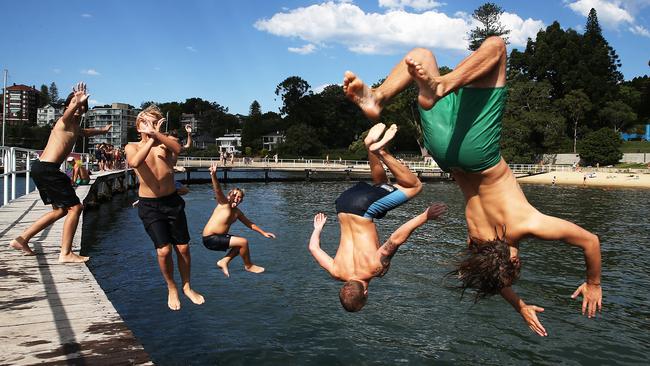East coast sizzles as power grid feels the pressure
Sydney has recorded its hottest day in two years as the eastern seaboard sweltered through its first day of a heatwave.

Sydney has recorded its hottest day in two years as the eastern seaboard sweltered through its first day of a heatwave that ignited bushfires, forced schools to close and sent residents swarming to beaches and waterways to beat the heat.
Temperatures as high as 38C to 40C were recorded across NSW on Monday, including 40.6C at Sydney Airport, 40.1C in Penrith, 39C in Bankstown in the city’s west, 40.1C in Coonamble in the state’s central west and 41.6C in Bourke in the northwest, Bureau of Meteorology figures show.
The heat is predicted to linger into Tuesday, with Sydney forecast to reach 34C, as a trough moves north into Queensland keeping temperatures high, with Brisbane forecast to reach 33C on Tuesday, Ipswich to hit 35C and Toowoomba 32C.
The burst of hot weather after three cooler La Nina summers was a sobering reminder of the pressures that hot days could put on an energy network, whose baseload capacity is being steadily reduced with the closure of coal-fired energy plants.
Energy demand in NSW reached 13,018 megawatts about 6.30pm (AEDT) on Monday, outstripping predictions that demand would peak at 12,600 megawatts, as heat-stressed residents cranked up airconditioners in a bid to escape a type of searing heat they had not felt for two years, figures from the Australian Energy Market Operator show.
The grid had enough supply to meet demand, but energy experts warned that multiple days of scorching temperatures could outstrip reserves.
Monday’s energy supply was made up of 60 per cent black coal, 11 per cent hydrogen, 10 per cent solar, 10 per cent gas and 8 per cent wind power, AEMO figures show.
Bureau meteorologist Livio Regano said a line of low pressure would work its way north over the coming days bringing temperatures down to the high 20s across much of the east coast later in the week.
“The warm north winds are affecting Sydney (on Monday), as this system is gradually pushing north over the next few days … and so you get warm air getting displaced by cool air as it continues to shift,” he said.
“When that system goes through, the wind suddenly changes from northerly to southerly, that’s when you get your cool change.”
More than 30 schools were closed across NSW on advice from the Rural Fire Service, including Black Springs Public School, Hill End Public School, Borenore Public School and Canobolas Public School, amid a spate of fire danger warnings.
Total fire bans were in place in NSW across seven areas with firefighters battling to contain 38 fires, with 15 still fighting containment late on Monday, mostly in the state’s central west, according to the NSW Rural Fire Service.
Two bushfires were still burning at emergency warning level in Tambaroora and Cranbrook, both in NSW’s central west, with grass fires at Girilambone and Burrendong still listed at watch and act level on Monday night.
RFS spokesman Gregory Allan urged NSW residents to adhere to fire warnings and be alert, adding that Tuesday was expected to be another day of extreme fire danger with two areas under total fire ban.



